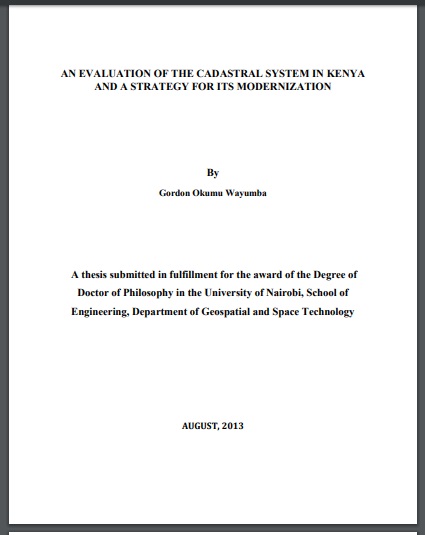Resource information
The Cadastral system in Kenya was established in 1903 to support land alienation for the white settlers who had come into the country in the early part of the 20th Century. In the last hundred years, the system has remained more or less the same, where land records are kept in paper format and majority of operations are carried out on a manual basis. The lack of a modern cadastral system has contributed to problems in land administration in the country. The Government has expressed the need to modernize the cadastral system in order to facilitate better land administration, support the development of an integrated Land Information Management System and a National Spatial Data Infrastructure. However, one persistent denominator to these efforts has been the lack of strategies for such modernization. This study set out to contribute to the solution of this problem through the following objectives; to evaluate the current cadastral system in Kenya, to identify and analyze appropriate technologies and strategies for modernization of the cadastral system in Kenya, and to test the suitability of the identified technologies and strategies in the cadastral system. The Methods adopted included; administration of standard questionnaires to selected stakeholders, personal interviews, field observations and review of existing literature on cadastre. Stake holder involvement in the study consisted of private and public sector Land Surveyors, Lawyers, Valuers, members of Co-operative organizations, and general users of cadastral information. The study also carried out field measurements with selected geospatial technologies in selected study sites to assess their suitability in cadastral mapping and modelling. These technologies included; Global Positioning System, high spatial resolution satellite imagery, and Geographical Information System. Further work involved the development and testing a new cadastral model based on the Multi-Value Vector Maps approach and Smiths Normalization procedures. The main results from the research are that; the administrative structure is bureaucratic, complex and highly centralized; the cadastral processes are equally complex, duplicative and slow; and all the tested technologies were found suitable for cadastral mapping and modelling, however, the GPS technology lacks proper guidelines for application and calibration bases. In terms of cadastral modelling, it was found that Smiths Normalization and Functional Dependency Diagrams automatically produce fully Normalized Tables and successfully query and display of multi-parcel ownerships. The study also found out that a hyghbrid of ObjectRelational database management system is better-suitable for the development of GIS-based cadastral databases than typical Relational or Object-Oriented models on their own. The study concludes that the main problem with the cadastral system in Kenya is lack of computerization and decentralization, and therefore recommends for a complete decentralization of the administrative system and implementation of a comprehensive computerization possibly through the development of a Land Information System



